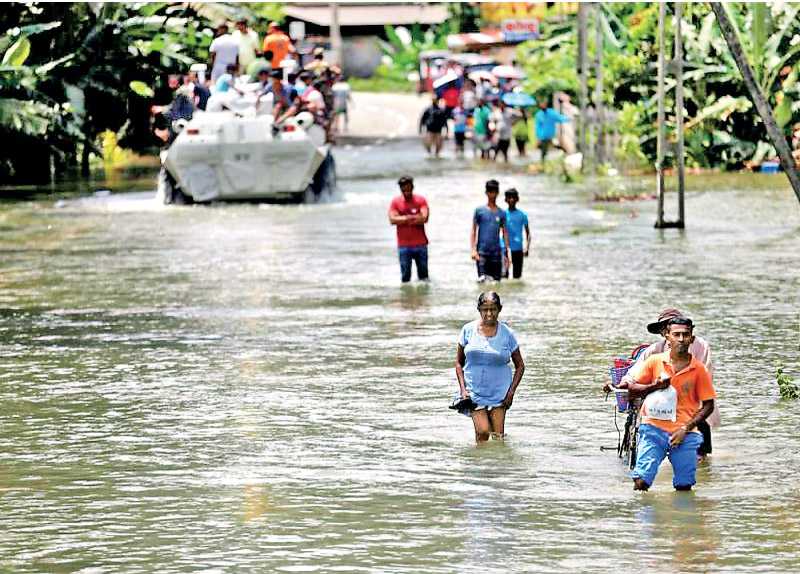Wednesday Dec 24, 2025
Wednesday Dec 24, 2025
Thursday, 18 February 2021 00:00 - - {{hitsCtrl.values.hits}}

Sri Lanka has been identified as a country with a higher displacement risk due to disasters in South Asia – Reuters
 Rural to urban migration is a common phenomenon in any country. This type of migration is mainly influenced by socio-economic factors, like getting better employment opportunities and higher living standards. According to the World Bank, 55% of the world’s population currently live in cities and the figure will increase to 70% by 2050.
Rural to urban migration is a common phenomenon in any country. This type of migration is mainly influenced by socio-economic factors, like getting better employment opportunities and higher living standards. According to the World Bank, 55% of the world’s population currently live in cities and the figure will increase to 70% by 2050.
In Sri Lanka as well, rural to urban migration is constantly happening, and the capital Colombo and its suburbs experience it on a massive scale. The majority of those who live in Colombo slums are believed to be people who migrated from rural areas in search of employment opportunities in the city. However, with the onset of civil war in the 1980s, the migration rate further increased as many living in war-torn areas started to leave their places. Sooner than later the phenomenon of internal migration would be boosted when people start to migrate due to climate change impacts. This type of migration is called climate migration or environmental migration. The World Bank predicts that climate change could force over 140 million to migrate within countries by 2050.
Climate migration can take many different forms: forced and voluntary, temporary and permanent, local and cross border, individual and group, and of short-distance and long-distance. Other important characteristics of climate migration are the nature, duration and scale of it. Sometimes, the causes would be slow processes like increasing temperatures, sea-level rise, change in rainfall patterns, and land degradation.
On the contrary, floods, cyclones, and high-intensity rainfall-induced landslides act as sudden-onset events. However, climate migration can have either positive or negative results. On the positive side, it will help people be safe improving resilience and on the negative side, people can be vulnerable to many different hazards when exposed at their new locations.
Perhaps, those who migrate to urban areas expecting better opportunities may end up in miserable situations if they are deprived of good living conditions – many will face anew issues like lack of good quality water, sanitation, exposure to health risks, and children would be deprived of their education.
Climate migration is not new
According to archaeological evidence, climate change has affected ancient human settlements and the formation of civilisations of Egypt and Mesopotamia is a consequence of that. People have left the water-stressed arid areas and settled in riverine areas. Likewise, the expansion of communities in Mediterranean and southern Europe in the 8th century is believed to have been driven by the drought in the Middle East.
As observed throughout the world gradual environmental changes due to climate change have led to the migration of people though this has been a slow and ongoing process. When people were exposed to repeated climate change shocks, they had moved a long distance away from such harsh areas, as their livelihood and well-being were no longer secure. When people engaged in agriculture in rural areas found it difficult to survive from farming due to water scarcity, especially farmers engaged in rain-fed agriculture, they had moved to urban areas searching for alternative means of living. Albeit, people who opt to live elsewhere will try to choose different destinations that they perceive as more suitable for their expectations.
Predictions of climate change
The intergovernmental panel for climate change (IPCC) in its latest reports has indicated that the South Asian subcontinent will experience a 2 Celsius rise in temperature by 2050. Yet another report by Reuters reveals that 63 million South Asians will move to urban areas leaving behind their rural settlements by 2050. The main driver of such movement is cited as the inability to support their cultivations.
The growing water scarcity would lead to crop failures or difficulty to raise livestock anymore. Further, rainfall patterns will drastically change and probable high-intensity rains would cause severe flooding at some places. Moreover, high-intensity rain will wash away fertile topsoils reducing agricultural productivity.
Many people will have limited natural resources, such as drinking water. Other impacts would be extreme temperature, wildfire, and wildlife issues. Saltwater intrusion into the rivers is also on the rise due to dwindling flows during dry spells. Although not yet experienced on a grand scale, even there would be chances of sea-level rise and more intense coastal storms displacing people living in coastal areas.
What could lead to climate migration in Sri Lanka
Sri Lanka is one of the countries least responsible for greenhouse gas emissions, though, unfortunately, ranked as a country highly vulnerable to climate change impacts. It is predicted that wet regions in Sri Lanka will be getting wetter while dry areas will be getting drier with climate change. In other words, we will experience increased flood and drought risks. Sri Lanka has been identified as a country with a higher displacement risk due to disasters in South Asia.
According to the estimates, 15 are at risk of being displaced out of every thousand inhabitants in Sri Lanka on yearly basis. In 2017 alone, 135,000 people have been displaced by a series of disaster events where floods and landslides were dominant. During many rainy seasons, landslide warnings are issued to central hilly areas prone to landslide risks. The vulnerable people from these climate-induced disasters are often the rural poor, if not the urban poor.
Sri Lanka still has a low adaptive capacity to climate change impacts according to the geography and fragile ecosystem. The rural poor in the country that depends on agriculture is about 70% and they are producing 80% of local food demand. A vast majority of them engage in rain-fed agriculture, which is highly vulnerable to climate change impacts.
Climate migration out of coastal areas is also probable in the future according to the predicted sea-level rise and coastal storm surges as many of our coastal areas are densely populated and many occupants of those areas are engaged in fishing and tourism-related businesses. Nevertheless, the country will hardly see any movement of people out of the country due to climate stressors, being an island nation having diverse agro-ecology.
How to deal with the issue
Improving the resilience of vulnerable populations seems to be the most viable solution to climate migration. For the sustenance of agriculture, traditional crop varieties should be replaced with climate-resilient crops that can withstand climate stresses, especially in rain-fed areas. Many serial food crops like maize, barley, green gram, and soybeans are such varieties, according to agriculture experts. Similarly, vegetable and fruit varieties, which could tolerate climate stressors, should be grown in these areas.
With regard to improving resilience to flood risks, construction of flood defences and development of flood-proof settlements are vital strategies. Development of water resources to meet demands in dry zone areas that are highly prone to drought hazards is to be expedited. To this end, implementing possible reservoir projects and trans-basin water diversion projects is important and farmers harshly depending on rain-fed agriculture should be allocated irrigable lands developed under those projects.
Researching on migration dynamics coupled with climate change scenarios is also important owing to the complexity of the issue. Before the preparation of better policies in the future, it is very important to know the migration patterns in detail as human movement is inextricably linked with socioeconomic factors as well.
It is also important to educate and help people make better decisions on migration. People should be warned to stay where they are unless the new locations they want to move into are less vulnerable. Lest the country plans for it now itself, climate migration will be another crisis in the future.
(Eng. Thushara Dissanayake is a Chartered Engineer specialised in water resources engineering with over 20 years of experience.)